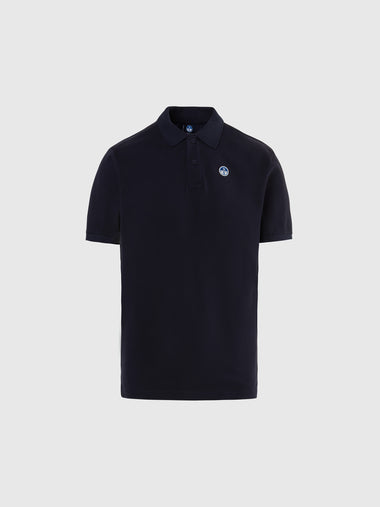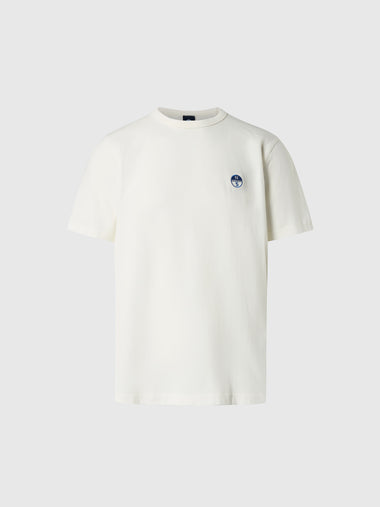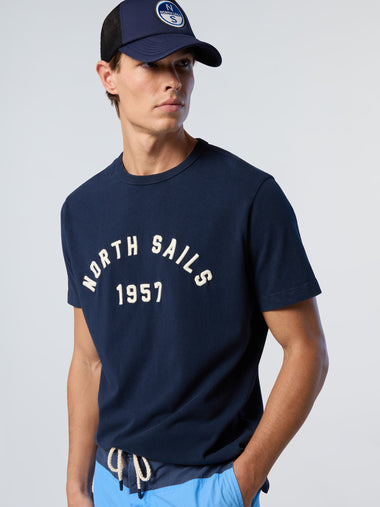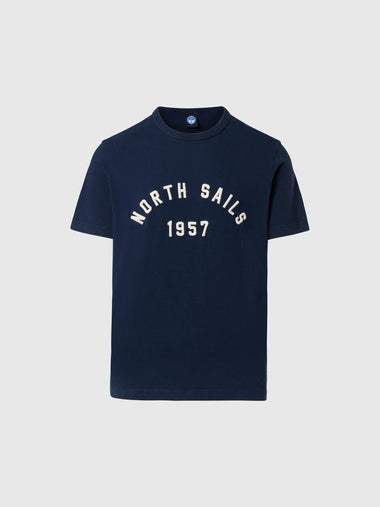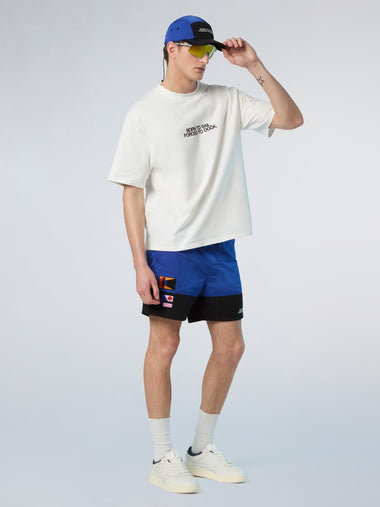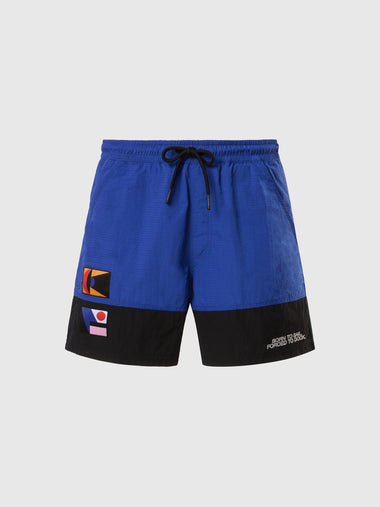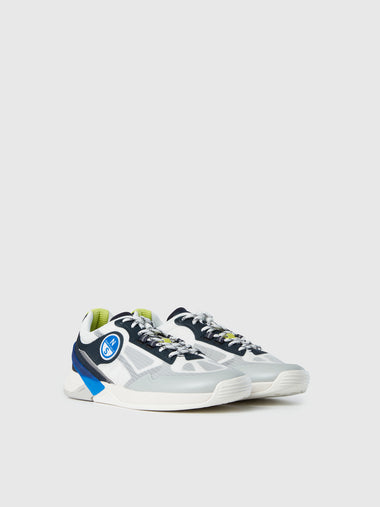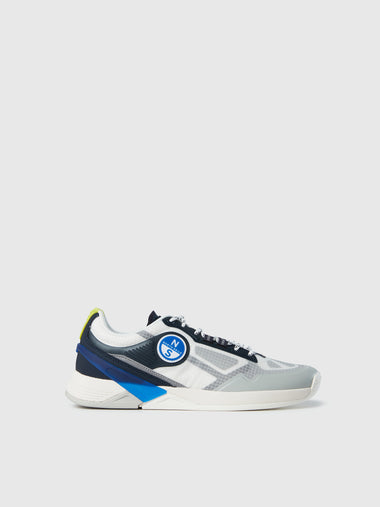NORTH SAILS BLOG
Tutto
Events
Guides
News
People
Podcast
Sustainability
Tech & Innovation
Travel & Adventure

LET'S TALK J/24 | UPWIND & HEAVY AIR TECHNIQUE
LET’S TALK J/24
Upwind & Heavy Air Techniques
North Sails J/24 experts Will Welles, Andrea Casale and Mike Ingham talk about J/24 heavy air techniques.
Webinar topics include:
5:03 – J/24 Blade Jib vs Genoa decision
11:45 – Balancing the J/24
26:45 – Trimming the J/24 Genoa
54:00 – Trimming the J/24 Blade Jib
1:05:56 – Sailing the J/24 in 25+ knots
Complete information on J/24 sails
READ MORE
READ MORE
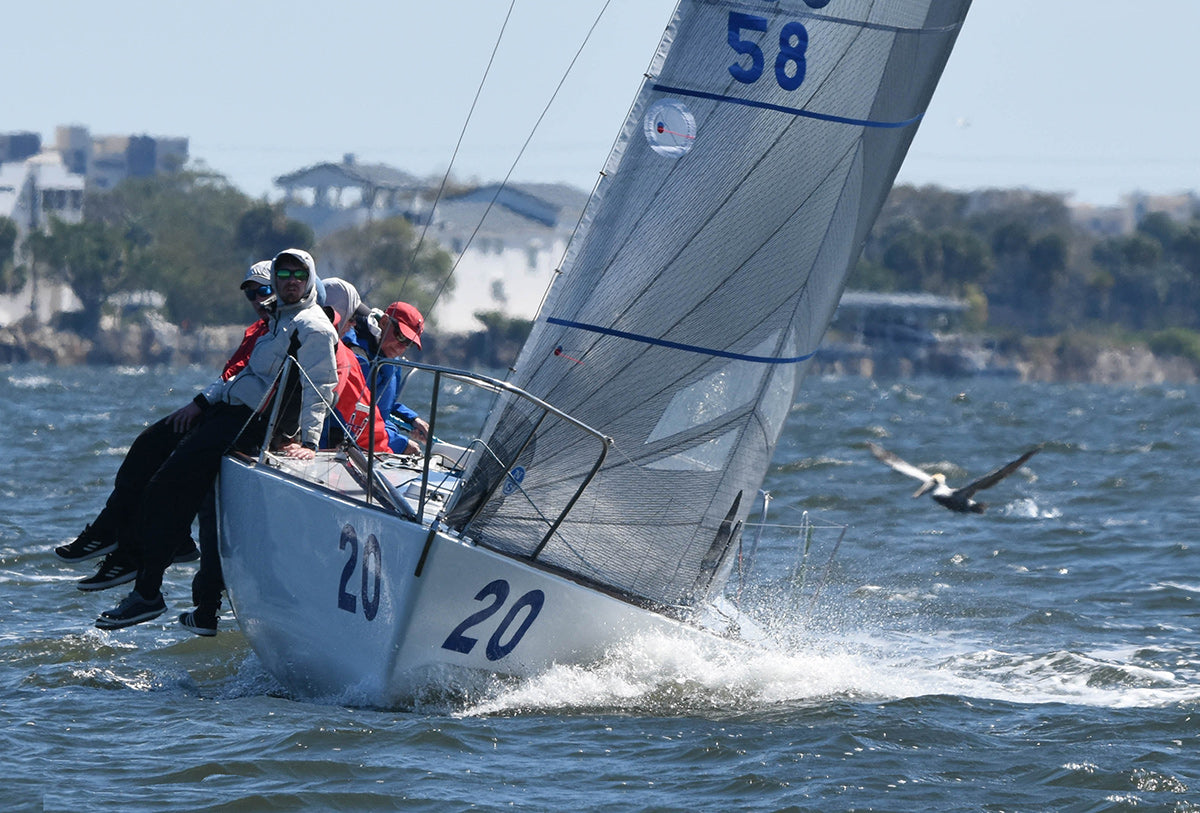
2020 J/24 MIDWINTERS: A WELL DESERVED WIN
J/24 MIDWINTERS: A WELL DESERVED WIN
Congratulations Tony Parker & Team Bangor Packet
2020 J/24 Midwinter Champions 📸 Chris Howell
After 41 years in the class, Tony Parker on Bangor Packet finally won the J/24 Midwinters in Melbourne, FL—by one point. After eight races, only two points separated the top four teams, indicating unusually close racing among the top group including John Mollicone, Mike Ingham and 2019 World Champion Keith Whittemore.
We caught up with Tony after the regatta to get his insights.
You’ve been sailing J/24s for a few years. How have the class and boat evolved?
To say “a few years…” is an understatement. My first major regatta was the 1979 Worlds. We sailed with 4 people, weighing in at most 600 pounds, with a reefable mainsail. The self-proclaimed “family cruiser” had the required cushions below. If only I had known then 25% of what I know now!
What was your team’s strategy to pull off this win?
We just tried to get off the line clean, look around about halfway up the first leg to see how we stood, and then started to play against the others up there. Our tactician, Zeke Horowitz, called a great regatta. He was very patient, probably more than I would have been. Because of that we never got too out of phase and when we lost distance, we would gain it back in the next shift.
The top people were all very close. The fourth place boat averaged a 3rd for the regatta out of 33 boats. I haven’t seen such a tight top group in years – and all the top five boats at the Worlds were there, so the competition was really tight.
The fun part was that this was the first major J/24 regatta I have ever won. I bet I have over a dozen 2nd places. I never thought it would take me until I was 74 to get there!
Team Bangor Packet 📸 Chris Howell
Tell us about everyone’s role on your boat.
Each person has an assigned role. We are quite good about keeping the talking down and we are quite gentle when one of us screws up. I screw up more than anyone else but most of the time they don’t yell at me. Our second person back, Emmet Todd, was really helpful because he was very active calling puffs. So many who do that job just never stop talking and finally I start ignoring them. He was particularly adept at not “overtalking”. It really helped me anticipate puffs and lulls. We have a terrific team.
Zeke Horowitz, our tactician, is as good as anyone in the world. He is patient, clear and never panics when it gets tight. We are very clear who has the “con”. Sometimes it is our spinnaker trimmer; sometimes it is me; most of the time it is Zeke. The transitions are very seamless.
James Niblock, our jib and spinnaker trimmer, has been sailing with me for over a decade. He is as good as they get. We know each other so well that we almost don’t have to say anything to each other. He always anticipates what is needed in terms of trim, besides being a wonderful shipmate.
Will Bomar, our bowman, does everything. He makes sure the boat is in perfect condition. I am a man of leisure before and after the race because I know he and James have the boat perfectly set up.
We were lucky to have Emmett Todd, who usually sails with Finn Hadlock, act as our twing man, replacing my “go to” forever shipmate Ross Dierdorff. We all miss Ross, but Emett did a first class job and I will always be on the lookout for him if Finn can’t make a regatta. They are really good.
📸 Chris Howell
You sailed some races in the Genoa and some races in the Blade jib. How did you decide on which sail you used?
That ultimately was very simple: we looked at our competitors. If all of my major competitors were sailing with a particular sail, we just followed suit. The price for being wrong is too high!
A few of your team members had flown straight from sailing J/24s in Argentina. Can you tell us about the 2021 Worlds venue?
It was very different. They sailed with 4 people at that regatta and the venue is too narrow to be able to sail to a layline, so there was much more tacking. The breeze is quite consistent but the shifts are not. The hosts were very welcoming and will put on a fun Worlds next year.
Job well done! 📸 Chris Howell
READ MORE
READ MORE
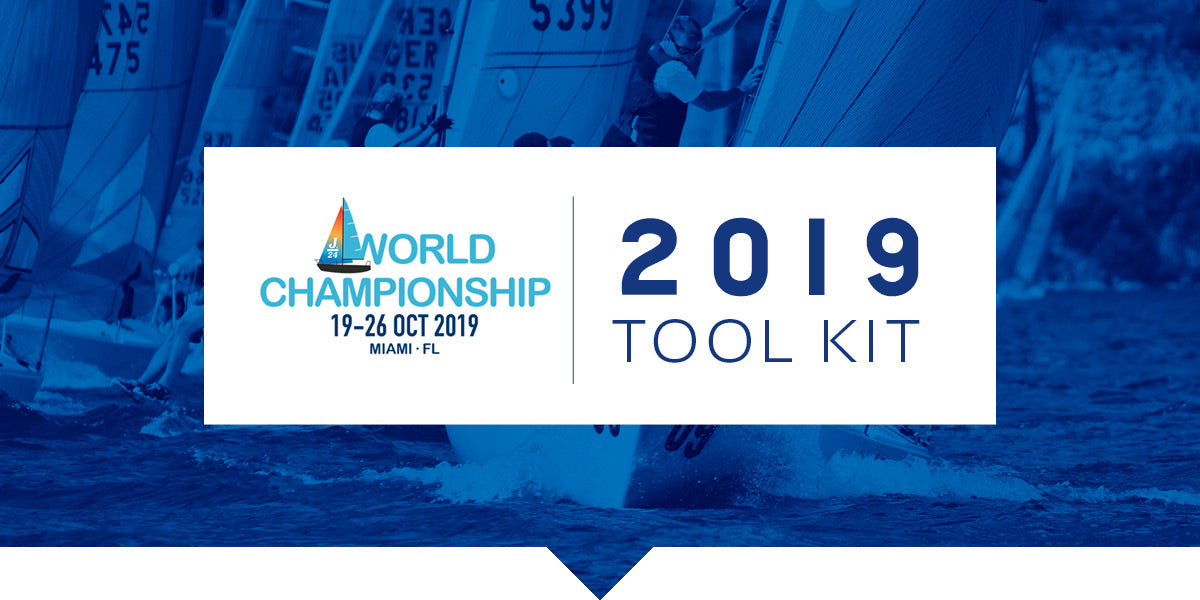
2019 J/24 WORLDS TOOL KIT
Get The Most From Your J/24
The 2019 Worlds are just around the corner. Is your team ready? Our J/24 Tool Kit will help.
Scroll down for tips about boat speed, tuning, shifting gears, jibing in breeze, and much more. Created just for J/24 sailors, by our team of experts.
Get To Know Biscayne Bay
To help you prepare for the 2019 Worlds, we asked the local Star and Snipe World Champion Augie Diaz to explain about his home waters of Biscayne Bay in Miami, FL.
How The 2018 Worlds Were Won
It may not be Lake Garda, but Miami could serve up some similar conditions where tuning and sail selection comes into play. We can expect a little bit of everything at the 2019 Worlds, and you may see some recurring themes from Garda that find their way to Biscayne Bay.
Shifting Gears
Two-time North American Champion and North Sails expert Mike Ingham explains how to shift gears when pressure is unpredictable.
Fine Tune With North
Find your groove. Get your numbers. After countless hours of sailing, sail testing, and competing in the J/24, our World Championship winning sails will get you up to speed quickly with our newly updated tuning guide and matrix.
Jibing With Authority
The key to perfect jibes is practice, practice, practice. Get the play-by-play on how to execute a jibe with success.
#NSVictoryList
There is no better performance test of a one design sail than the results it produces. In 2019 alone, North Sails J/24 inventories have powered many teams to the number one spot all over the globe.
Let us help you achieve your end goal.
Building Your Confidence In Breeze
Windy day ahead? Here are 10 tips to help you conquer those days at the top end of the genoa’s range.
Videos: Get Your Team Up To Speed
World-level preparation works for smaller regattas too. Before your next regatta, watch our video tips from Tim Healy and Will Welles.
Preparing For A Big Event
Will Welles talks us through boat prep, tuning, how to put together a winning team, and regatta logistics.
Define Your Speed
Pulling all the pieces together can be challenging. Our J/24 Speed Guide will help you leverage our expertise to make the most of your sailing.
Common Questions, Answered
We respond to 13 of the most frequently asked questions about racing a J/24 well.
Trust In Our Expertise
We’ve been winning in the J/24 since the class started, and we can help you win too. Contact your local expert, check out our inventory, and join us at the front of the pack.
READ MORE
READ MORE
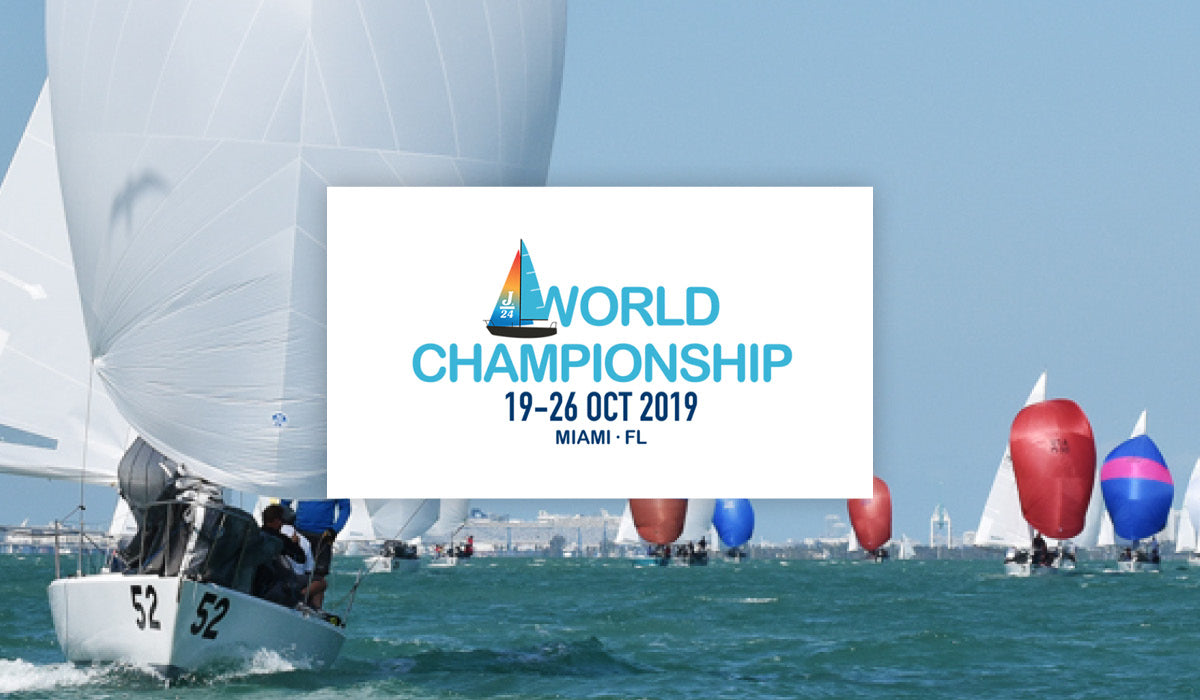
J/24 WORLDS LOCAL KNOWLEDGE
J/24 WORLDS LOCAL KNOWLEDGE
Get To Know Biscayne Bay
To help you prepare for the 2019 J/24 Worlds, we asked the local Star and Snipe World Champion Augie Diaz to explain about his home waters of Biscayne Bay in Miami, FL.
Biscayne Bay is I think pretty straightforward. The weather is driven by cold fronts approaching, and we don’t get as much breeze as we used to because the city’s grown so big. But generally, any breeze from the northeast around through the southwest is great sailing. From this direction, the breeze is usually under fifteen knots, with relatively flat water (chop but no swell). Spring and fall are the best seasons, because we don’t get many fronts.
Dominant wind direction: easterlies
The old rule of thumb is still the case: if the wind’s to the left of the south end of Key Biscayne, you go left. Near the Key, from 120-160 degrees, there is a little more pressure closer to the end of the Key, and also a geographical shift off the land. How favored is somewhat current-dependent; from 70 degrees to 160 degrees with an outgoing current, then left is really good, what we call the “Old Man Expressway”. At the top of the beat on the J/24 Worlds course, the Old Man Expressway could be important.
On what I call the Cuba Course, where the Etchells sail, way down south of Matheson Hammock, there’s less left down there than there is closer to the point of Key Biscayne. So you have to keep in mind where you are on the Bay.
Current
Understanding the current is very important. People think the current comes in and out of the Bay from the east, but it actually runs in and out from Bear Cut. If you get close to what we call the Valves, which are the channels through the shallow areas that on the chart are labeled Biscayne Flats, there is a component of current going in and out of there. But you have to be very close to the Valves for that to be the net effect. Otherwise, the current basically ebbs from the southwest to the northeast, and goes the opposite way when it floods.
As for the timing relative to high and low tide, I’ve seen it as much as an hour off, so I just use tide change as a gauge and then keep checking the buoys, all the time. Sometimes seaweed will show lines of current, but I’ve never really seen a change in the color of the water.
Other wind directions
Once the wind gets to about 170-180, it’s pretty important to protect the right. That’s true all the way to 220 degrees. Anything right of 220-230, it’s going to march quickly to the northwest because that’s a frontal-driven direction, which doesn’t doesn’t have the ability to stick.
If the wind’s right of 230 degrees, I like coming in from the top left because you get some really nice puffs off the left shore. It depends where you are on the Bay; on the J/24 course, close to the west shoreline, you’ll definitely want to come in from the top left.
Northwesters are like you’re on a lake: very shifty, very up and down. But in late October, it’s actually less frontal, so that’s less likely.
Secret to success
Focus on what the current’s doing, and in the easterly understand how important it is to go left.
Thanks Augie!
READ MORE
READ MORE
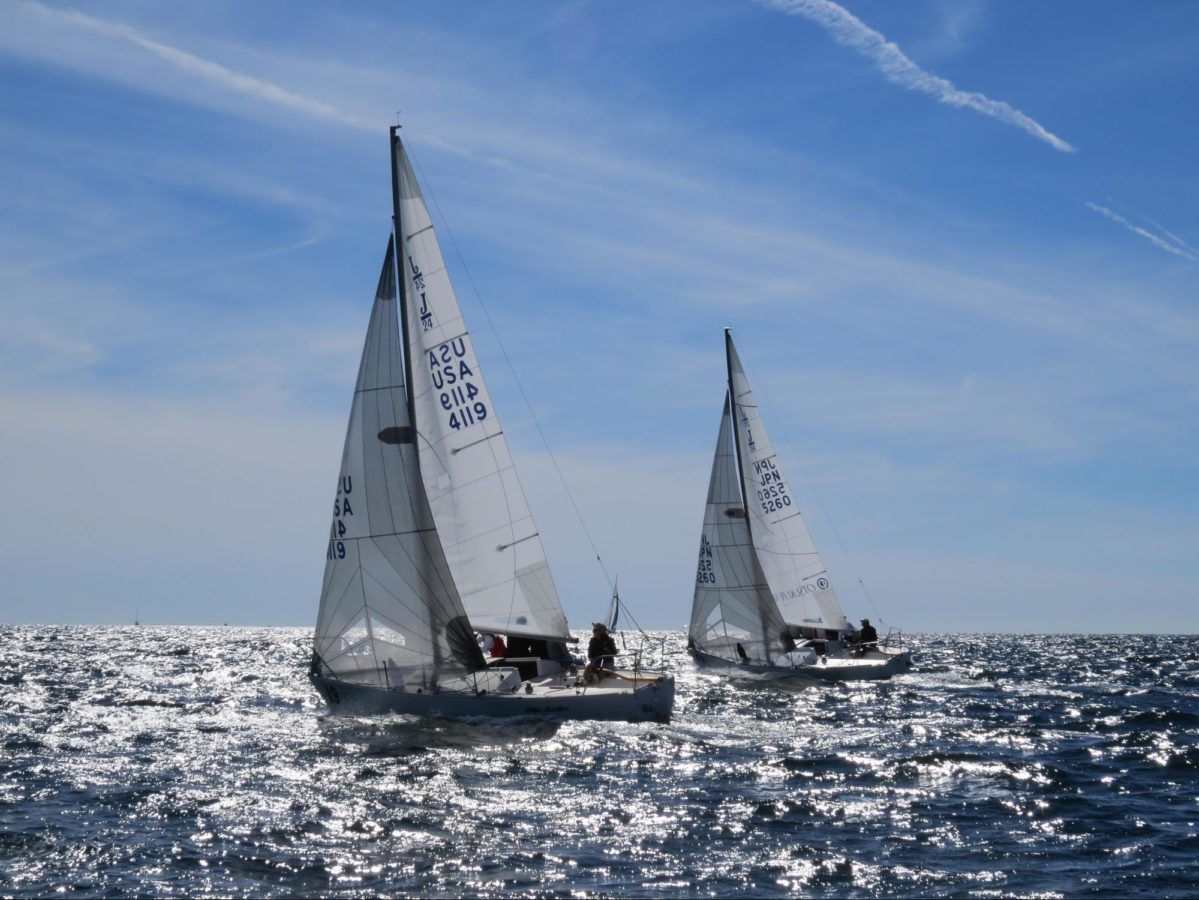
J/24 US NATIONALS: LOCAL KNOWLEDGE
J/24 US NATIONALS LOCAL KNOWLEDGE
North Sails Expert Mike Ingham Explains What To Expect in Rochester
They call Rochester “Leftchester”. But of course it is not always that simple! We asked North Sails expert and Rochester local Mike Ingham what sailors should expect when they leave the docks at the 2019 J/24 US Nationals.
First, some basics:
The predominant winds are in the West quadrant (WSW to NW).
More often than not, systems come from the West quadrant, most often WSW
The thermal is NNE
The Genesee River flows North to the lake passing through Downtown Rochester before dropping considerably in altitude, passing RYC and emptying it’s silt into the lake
The racing area is typically straight North or NE from the river. It’s not quite in a bay, but the land does indent like a very open bay, so there is land from West through South to East. From West through North to East is largely exposed
The Lake is large and deep. It is around 350 miles long and 70 miles wide. The Niagara River flows into the lake on the SW corner and that water empties into the Atlantic by way of the St. Lawrence River in the NE corner
Here are some thoughts for each direction:
South Quadrant:
It’s shifty in all of the South directions.
The city of Rochester is ~8 miles up the Genesee and over 400 feet above the lake. That means the wind coming down that long hit is really unstable as it tries to mix in with the air below
Heads up puffy lake sailing.
Since the wind comes down that long hill, sometimes the puffs don’t hit the water so you don’t see them coming. Need to look and try and connect the puffs, but also need to be ready to react to whatever comes your way.
Top of the course is the most shifty because it is closer to land making the last move to the weather mark and the first move out of it pretty critical
All S directions (system driven)
Flat water
SOUTHEAST
Can happen, but is not common. Almost always associated with some rain and storm coming, but not always
Can get a lift off the right shore, but not consistently
Not a sustainable direction, it is unlikely to lock into the SE for more than half a day before something changes it
Will rarely turn into a thermal because it is associated with bad weather disrupting any land convection.
SOUTH
Relatively common system breeze
Often warm clear weather
Super shifty
Rarely any geographic pattern (like get to a shore) because relatively square to the land
SOUTHWEST
Relatively common system breeze
Can be nice clear warm weather, or can be humid with t-storms rumbling through especially in the afternoon
Can be very windy, but is relatively flat
Very shifty puffy – heads up!
West Quadrant
Common System driven
Often windy, clear
Relatively steady compared to the S winds, but still some shifts
Can have T-storms associated, especially late in the day
Out further in the lake, there can be big waves, but where we race there is a shore to the West, so that cuts down on big wave. Still choppy though.
Often very favored left because of a lift off shore and flatter water
North, Northwest System
N or NW System breeze about once a month lasting a few days (when it is windy)
Cold wind from the North
Often windy
BIG steep waves (up to 10 foot)
In the spring and summer, this is an oscillating breeze, so play the longer shifts, could be 5 min + oscillations
But in the fall, since the lake is warm and the air cold, mixing makes for big holes and puffs
Northeast System
Rare
Unstable often rainy and stormy
Does not last long
Play shifts, but don’t expect a solid pattern
Can be big waves if it does last a while because it has a very long fetch from the East end of the lake. But often does not last long enough to build up the really big waves
Northeast Thermal
Almost always a Thermal Sea breeze
Lite. It rarely gets into double digits
Like any other thermal, need a temperature differential. The lake peaks at around 65deg so it can happen even on a cool day.
The lake can “turn over”. Only the surface is warm and if the lower cool water mixes, it can get cool overnight to the mid 50’s
Flat water
Even though it is coming from the lake, it only goes out a few miles and does not have time/ distance to build up much chop
Once filled in, left seems to work more than not
Current
Surprisingly for a lake, you could see up to 1.5kts of current. Usually W to E parallel to the shore (but occasionally it inexplicably goes the other way –some kind of eddy).
You can’t predict it but can easily tell which way and how strong by watching which way the river silt exits the river on your way out.
It is caused by the bathtub effect, plus the flow of Niagara Falls (W to E). The lake is 300+ miles long and a low pressure system at one end or the other will suck the water that way, then when that pressure system goes away, the water “sloshes” back.
It is relatively even over the race course, there is rarely any local eddy or current relief anywhere because the lake gets deep quickly. You have to go right near shore and we don’t typically race there.
READ MORE
READ MORE
NEW J/24 TUNING GUIDE & MATRIX
Updated Tuning Numbers For The PT-2 Loos Gauge
North Sails is never satisfied when it comes to making faster sails and offering information to help clients optimize the performance of the sails. With decades of experience sailing the J/24, North expert and two-time J/24 World Champion Will Welles has released a new Tuning Guide complemented by a Tuning Matrix for the J/24 class including numbers for the new Loos Gauge Model PT-2.
“We have condensed the information and added the PT-2 numbers which were missing. I recommend to download/print the new Tuning Matrix and take with you next time you go sailing. The matrix offers a starting point based on numbers of the average boats. We left some room for you to log in your own numbers and go from there.” said Will Welles.
Open New J/24 Tuning Guide
Download North Sails J/24 Quick Tuning Matrix: Loos Gauge PRO PT2 | Loos Gauge PRO Model B
READ MORE
READ MORE
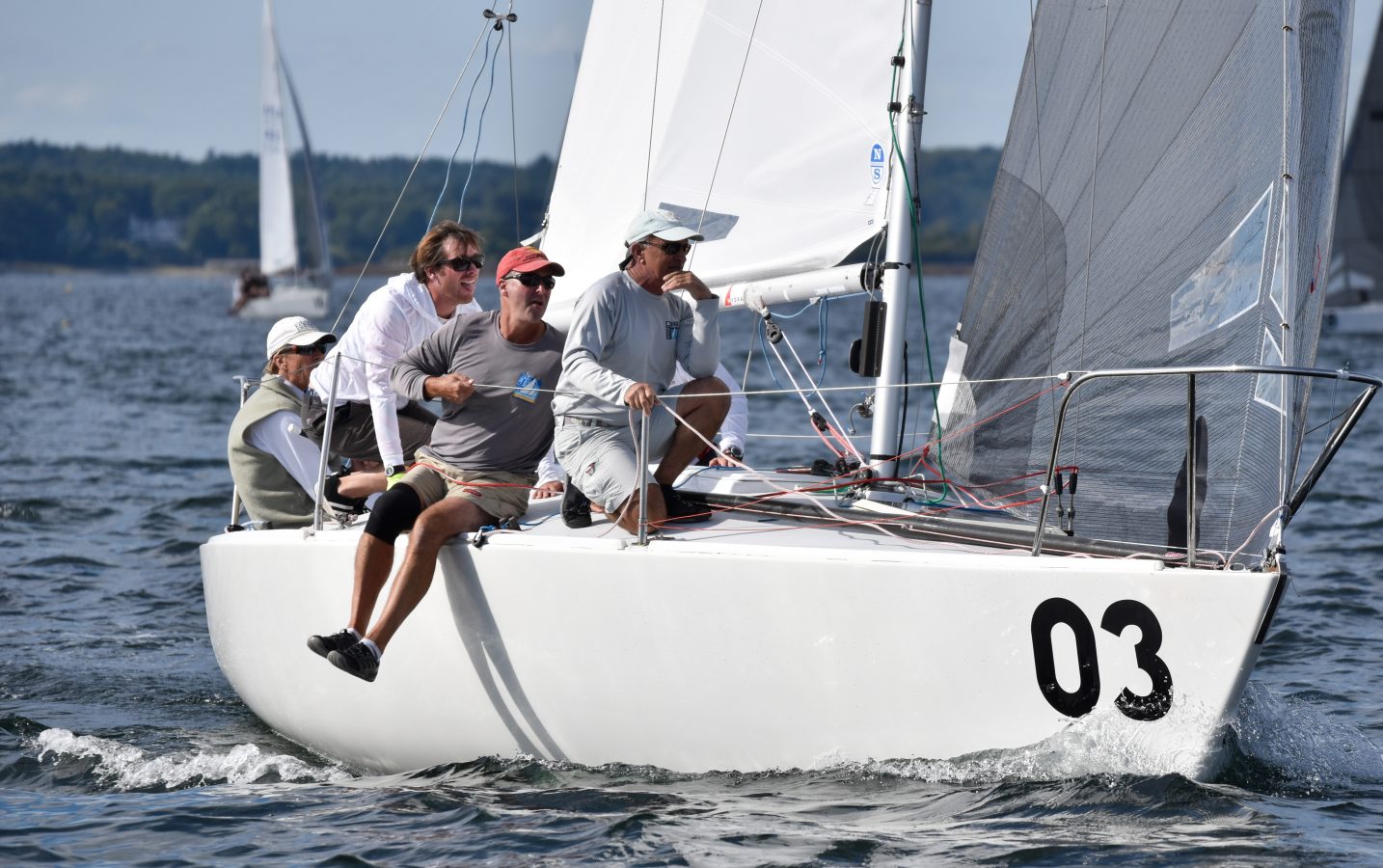
J/24 NATIONALS: MANAGING STRONG CURRENTS & LIGHT AIR
J/24 NATIONALS: MANAGING STRONG CURRENTS & LIGHT AIR
Class Veteran Robby Brown Shares His Top Secrets
© Chris Howell
The 2018 J/24 US Nationals were hosted by the Portland Yacht Club in Casco Bay. We caught up with Robby Brown, skipper of the winning team Angel of Harlem for some insights:
You have been sailing J/24s for years on and off, can you tell us a little about yourself, how you got into the class and what keeps you coming back?
I have been in the J/24 class since the Mid 80’s. I began sailing J/24s regularly around 1995. While I sail in multiple classes, I love the competitive nature of the J/24 class and its relative affordability of keeping a World Class boat going. Over the years, the class has always offered top level competition, that’s the biggest reason that keeps me coming back. Combined with the great atmosphere of the competitors and the class, I have always enjoyed my time spent campaigning the J/24.
Who crewed for you at the Nationals and how long have you all been racing together?
We have been working hard to put together a World Class team in advance of the Worlds in Miami. We are sailing together more regularly with team consistency than we have ever been able to manage in the past.
Our team consists of a group of sailors whose lives have been connected for many, many years as sailors that enjoy sailing together. The biggest factor gluing the team together at this point is my partner Mark Liebel. Mark and I are full partners in our pursuit of a top finish at the 2019 Worlds. We began sailing together nearly 15 years ago when I first moved to the Tampa Bay area. Over the years, we have developed a great friendship and ability to work together based on trust and truly enjoying working together in pursuit of team goals.
Ron Hyatt has been my most steady contributor with his rock solid bow work. He and I have been regularly sailing together for 15 years as well. Ron is a huge contributor in every aspect of campaigning the boat. He will help with deliveries and is always working hard on the dock to insure that we are prepared for a championship outcome.
Arthur Blodgett has developed into a huge asset in the trimming position and has been able to find the time to join us on a fairly regular basis ever since he graduated from college sailing as an award winning sailor. He was my best sailor when I was the collegiate coach at Eckerd College. We have been working together for almost 10 years.
Brian Simpkins was our fifth for the Nationals. He was new to the team but nevertheless a key to team success. Brian and Mark have been sailing together for many years, and I can’t say enough good things about the job he did stepping right in and making a huge contribution to our team success. We are definitely hoping he will join us some more in the future as a regular part of the team.
There is a fair amount of current where the Nationals were sailed this year, how did you figure it out so quickly?
Mark and I have sailed at the venue in the past and Arthur is from the area. We knew enough to have great respect for the need to figure out the current. We are all experienced at figuring out new venues. I am a high school sailing coach who regularly faces new venues with my teams. Mark is active in many classes and is diligent in his contributions to insure we have a good plan for the venue we are sailing in. In the end, I feel we did more homework on a daily basis than the competition, being able to process this information to insure success.
Here’s what we did:
We were determined to be the first boat off the dock, sailing the course area and examining trends and identifying course-specific opportunities to make gains.
We were checking current all of the way to the course area first thing in the morning. All of the lobster traps were great current tell tails.
We sailed both sides of the first beat in the morning to find the strong current. We examine where the water was rougher as an indicator of strong current.
We played the ever changing current more than wind shifts.
We made start strategies to get to the good current first and it paid.
What was your starting game plan against 50 other boats?
Hope and pray! This was true to some degree.
On the first two races we got caught up in crowds and were flushed at the start. Lesson learned, for the rest of the regatta we started toward the end that we liked, with a priority of staying away from the crowded areas. We would start just to one side or the other of the crowded area and still be as close as possible to where we wanted to be. With some good fortune, we had some great luck with starts in the last three races and were able to dig ourselves out and salvage the best possible finishes. Being able to escape the pack, and get out to the lead, we converted our good starts to 2-1-2 finishes, closing our gap to snag the victory.
We are constantly applying great focus to insuring we get good starts. The dynamics seem to be ever changing from event to event as far as getting off the line well. We feel that starts are the biggest benefactor of our ability to sail well at the Midwinters, North Americans, and finally the Nationals. Our big fleet start experience is definitely paying off.
You seem to have a pretty good light air gear, how did you set up your boat?
We definitely thought about this a great deal. We have been honing our speed for years and feel we have a particularly good gear in the light air. While we enjoy good boat speed in all conditions, the things we feel we do better than most in light air are a result of years of tuning, working with our North Team representatives, and living in an area where we get a lot of practice in light air. I noticed we did a couple of things differently than the most:
Primarily, we keep our mast butt well aft in the light air conditions.
This gives us the forestay sag that we utilize to really keep the boat powered up in light air. We never go below 20/15 on the rig. Rather, we push the mast butt back to get a really full genoa shape. This requires lots of scallops in the luff, as well as putting on backstay a little at times to pull some of the sag if the breeze gets bigger puffs or just picks up a little. We feel we are better pulling a little backstay on than we are if the rig was softer than 20/15. We felt like the puffs were a little too much for our tune. This has proven very successful for us
Secondly, we are weight farther forward and down in the boat more than anyone else.
Going downwind our spinnaker trimmer is one or two steps up on the cabin house, our tactician is standing on the cabin sole all the way forward in the hatch. Additionally our bow person and mast person go below and the mast person shifts from port to starboard side to balance the boat right up against the bulkhead and the bow person is in front of the bulkhead. I truly feel this was our secret to really superior downwind speed. We also had our fifth below upwind when it was very light. If he’s not hiking on deck, he is below against the bulkhead,
What sail designs do you use and why?
All of the North products are superior. Our choice for more years than I can count are Newport Upwind (Fat Head Mainsail, DX-7TT Genoa) and San Diego downwind (FR-2 Spinnaker). Rather than switching around between designs, we feel we have been able to get tremendous performance from these sails by sticking with the designs and honing our tuning of these sails over these many years.
Others have had great success with the many good product offerings available from North. We have been tempted to try something different a few times over the years, but we are always rewarded by our “if it ain’t broke don’t fix it” mentality. This has allowed us to develop our tuning model to a better than most performance through consistency.
What’s next on your sailing schedule?
We have a couple of great regattas on our schedule to close out the year here in Florida. We are preparing for the Southeast Regionals and Districts which will surely bring the best competition to the starting line. From there, we are working toward our best performance at Midwinters at our home Yacht Club, Davis Island.
We are planning to sail the St Pete NOODs as a tune up for the Midwinters and are hoping to coordinate tuning opportunities in addition to sailing as many of the major championships next year as possible. We hope to find good regattas in addition to the Nationals in Rochester, maybe some more NOOD regattas or the Newport Regatta. Please reach out to us if you would like to tune at these events. We are always welcoming tuning partners and opportunities.
© Chris Howell
READ MORE
READ MORE
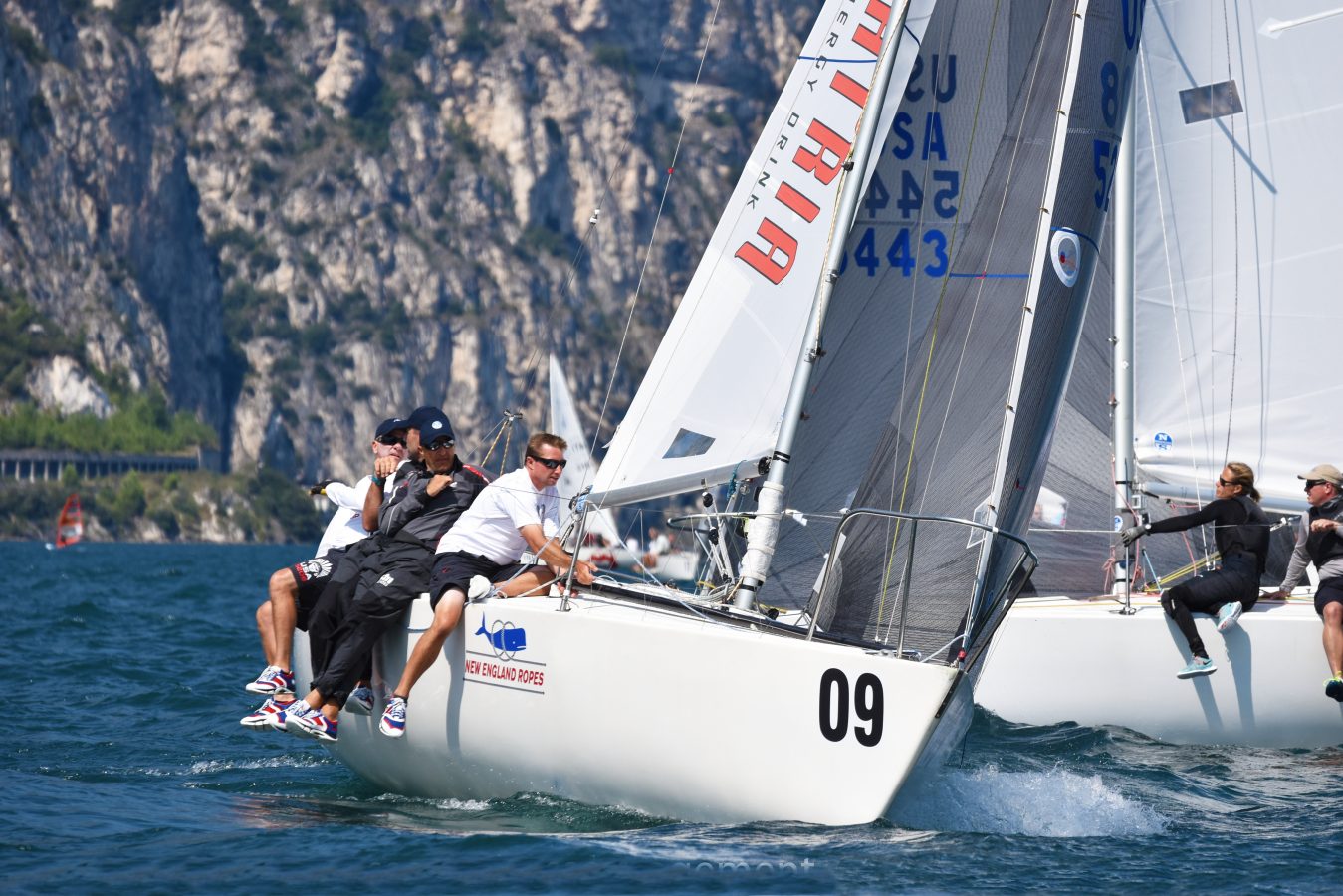
2018 J/24 WORLDS INTERVIEW
SPOTLIGHT: WILL WELLES, J24 WORLD CHAMPION
North Sails Experts Dig for Will’s Secrets to Win the Worlds
Eighty-nine teams from fourteen countries attended the 40th edition of the J/24 World Championship held in Lake Garda, Italy. North Sails One Design expert Will Welles won his second J/24 world title, dominating the scoreboard from day one, scoring 47 points over the course of ten races. Congratulations to team Kaster and crew Nick Turney, Rich Bowen, Giuliano Cattarozzi, and Andrea Casale.
Another great achievement to be noted, Keith Whittemore’s Furio finished 3rd place overall to win the corinthian division. Teams powered by North finished 1,3,5,6,7,9,10.
The North experts had some interesting questions for Will upon his arrival home from Italy. Here is what he had to say:
From Mike Ingham:
It was mostly flat water and windy, where/how did you set your genoa leads?
We call “touch/touch” our base lead position, this is when you trim the sheet in the mid-leech of the genoa touches the spreader at the same time the foot touches the chainplate. With the flat water and breeze we were mostly one or two holes aft from base. If we ever felt super over powered we’d move the lead aft and vise versa, if we felt under powered we’d move the lead forward. Seemed most of the days you could trim the genoa fairly hard with the lead back. As much as two inches of the spreader.
You were able to sail well at the high end of the genoa when much of the fleet switched to jib. How are you able to make the genoa work at the upper end without being totally overpowered?
It’s a sort of dance for sure! The key is to manage the angle of heel at all costs. Start with feathering the boat into the breeze in the onset of the puff, if that is not enough you will need to ease the sails, mainsail and the genoa. In 20+ knots with the genoa you will most likely have the genoa eased out to the lifelines. The mainsheet is eased in the puff and then trimmed on afterwards, I’ll wind the genoa sheet in when I feel we can take it. The backstay is on hard as well as the vang, the shroud tension is at our maximum tuning guide setting.
From Zeke Horowitz:
Any tips for stepping into a charter boat for the first time and trying to get it all set up the way you like it?
We were lucky with our charter boat, it was a fast boat but we did our homework months in advance. With the help of a local friend we found a good boat, which is a start but then you need to do all your homework so you can be prepared once you arrive. The key is to not burn up sailing days with unforeseen boat work. I like detailed pictures of the boat, pictures speak a thousand words….you can see how the rigging is, blocks, cam cleats, keel, rudder, mast, etc. I also send a list of yes or no questions to the boat owner, this way it’s easier for them to just say yes or no. We prepared what we needed to bring to make sure the boat didn’t have gear failure…and we brought some of the things we like to have on the boat that may not be there…winch tops, tiller, something of that nature. We make the list, gather the items, and pray it all fits into your luggage!
We heard it was imperative to get a good start at the favored end so you could be one of the first boats to the geographical shift. How did you balance conservative strategies with being aggressive enough to be one of the first boats off the favored end?
Yes, the start! Where you started and being able to get onto port straight away was the key to success. Surely it seemed you needed to be in the fray to get a good position off the start. Garda isn’t a place you can be conservative and start down the line in a less congested area. It was dicey to say the least but a must! Most everyone who started on the right end knew the deal, once in awhile you’d get one or two boats that wouldn’t tack right away and that was death.
From Mike Marshall:
What was the base setup? Prebend? Forestay sag? Upper and lower tension?
Our base set up was the same as always, 20/15 (uppers/lowers) with the silver loos gauge model B, 2 ¼ prebend measured at the spreader and two fingers on the headstay (measured with Loos gauge B). Garda is known as a windy venue with flat water and the world’s week was no different. With the flat water and breeze we were faster to make the rig tighter, faster then if it was a windy wavey venue. We always set up the rig for the first beat and figured if the breeze dropped out then we’d be able to manage through. I seem to remember we mostly sailed at 29/27 on the shrouds. Sometimes a setting tighter and sometimes a setting lower.
From Chris Snow:
What model genoa did you pick for the event and why?
Stick with what you know! We used the DX-7TT genoa, also known as the “Newport Genoa”. The SD-TH and DX-7TT are close enough in shape that we feel we can make one look nearly like the other with halyard and lead position. I think the key is knowing your settings, when to go where with the sail controls we have available in a certain condition.
From Skip Dieball
What was your favorite dinner while in Italy?
Hands down the dinner we had at Guiliano’s house, what a beautiful spot he and his family have! Guiliano owns Kaster the boat we sailed.
What was your key to getting good starts?
We were very fortunate to get decent enough starts to go the way we wanted to the first beat. The key in Garda was to battle for the right side of the line. You needed to go right so even if you got a second row start with speed you could get onto port and drag race to the right. If you started down the line and couldn’t tack you were in a really tough spot, if you stared down the line and were able to tack all the boats that were right of you were ahead by the end of the beat. So we just worked hard in the fray, time, distance to the line and looking for a lane out straight away.
From Ched Proctor
When do you decide it’s time to “Go to the wall?”
It’s always time to go to the wall in Garda! I think the question is which wall? Andrea says nine times out of ten the right works. Seemed to be true!
Are you the first American skipper to win a major event on Lake Garda?
I’m not sure! We will need to research that, somehow I suspect not, there is a lot of major events held in Garda in all sorts of different classes. One thing for sure, there may not be a prettier place to race! There is great breeze in the morning out of the North, it dies around noontime and then the Southerly comes in the afternoon. If you like wind and raw beauty Garda is for you!
From Marnie Jenkins
Sailing in Italy….did you have wine or water on board?
Water of course! Lots of good wine around Garda though!
From Chuck Allen
Is Rich Bowen on steroids to trim that well at his age?
I don’t think Rich is on the steroids, he says he works out which is the key to get the genoa in along with good timing! I wondered if Rich might be the oldest trimmer to win the J/24 worlds…Brad Read thought Moose McClintock was!
READ MORE
READ MORE
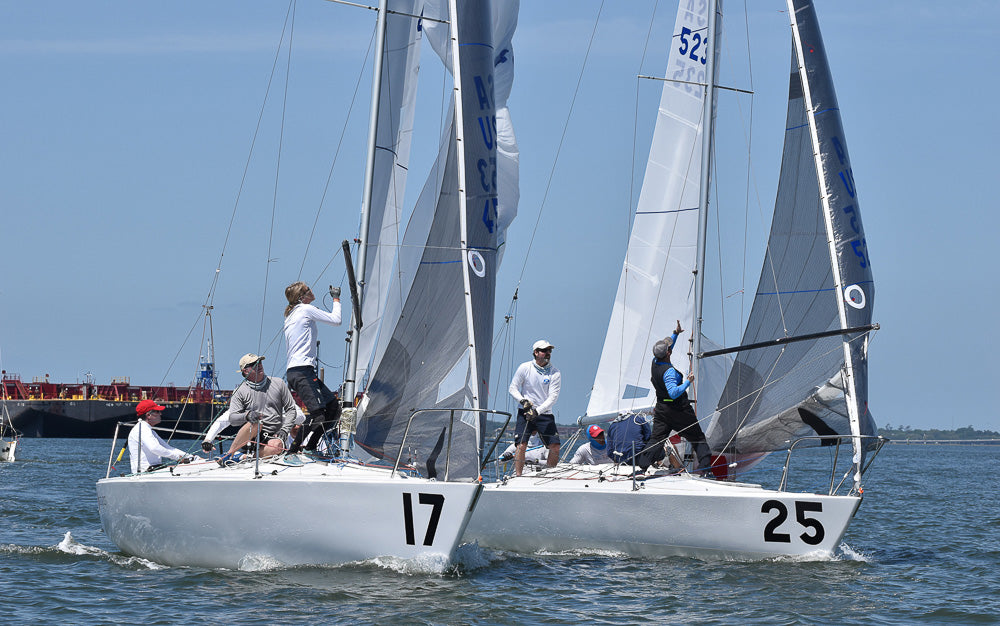
MIKE INGHAM WINS THE 2018 J/24 NORTH AMERICANS
MIKE INGHAM WINS 2018 J/24 NORTH AMERICANS
Tough conditions, three bullets to secure the title in a tight ending
The 2018 J/24 North American Championship were hosted by Charleston Yacht Club. For those that have not sailed there before there is a LOT of current, it is shifty and there are obstacles such as land, towers, and barges that all come into plan. It is a place where you need to sail heads up and have a sense of humor. You are going to make mistakes – lots of them, there is no avoiding them!
But with all that, boat speed matters. We had good speed and with that, we often won our side. Even if we were wrong, we could get out alive to claw back. Another advantage of speed in that crazy stuff is that we could break free from our pack and were able to then take advantage of a shift or other opportunity.
Conditions were flat water and all genny (no blade), but within that, we had a wide range of velocity form almost drifter through top end of the genny. Since it was flat water, we set the genoa leads to “touch –touch”, meaning when we over-trimmed the genoa, it touched the spreader and the chain plate at the same time. Then we sheeted hard on both main and genoa because we were now looking for power, and when we can get away with it in flat water, the J24 likes to sail high.
But with all those shifts and the wind up and down a lot, shifting gears was the key to consistent speed. Here are the priorities we came up with:
Shifting Gears in Underpowered Conditions (0-about 8kts)
Body weight first. We tried to move crew weight to keep a constant heel of 5 degrees or maybe even a little less. I would say we sailed almost uncomfortably flat. My helm was neutral or even a had to push a little. I had the team move to keep that heel and they would make their best stab at it and I would fine tune it with “2 in” (meaning 2 crew would lean in), “3 out” (meaning all 3 were fully hiked)
We trimmed the genoa tight, maybe 3” off the spreader, but would ease both main and genoa a little for some waves or to help through any transition.
With any puffs, we would trim a little tighter to keep the leaches tight, in lulls we would ease to keep the leaches from getting too tight.
Shifting Gears in Overpowered Conditions (8kts +)
“Full hike” would let the team know that I need them all to hike as hard as they could and that would also be a reminder to myself that my mode has changed from underpowered to overpowered.
If I am looking to depower my first move is the backstay. With the backstay on, I would trim the main a little more because while the backstay flattens the sail, it also opens the leach too much. Conversely I had to remember to ease the mainsheet when easing the backstay so the leach would not be too hooked.
If that was not enough to depower, pinching a little in that flat water seemed ok.
The cunningham and genoa halyard went on too to help depower.
My last resort was easing the sheets. We rarely had to do so this weekend, and I only do this if I have exhausted all the other depower options.
We talked about this at our dock talk after racing Saturday. See video below.
Learn more about North’s fast J/24 sails.
2018 J/24 North Americans
1. Mike Ingham
2. Will Welles
3. John Mollicone
4. Carter White *
5. Nicolas Cubria *
6. Andrew Carey
7. Robby Brown
8. Steve Kirkpatrick
10. Kenneth Porter
* Denotes Partial North Sails Inventory
READ MORE
READ MORE
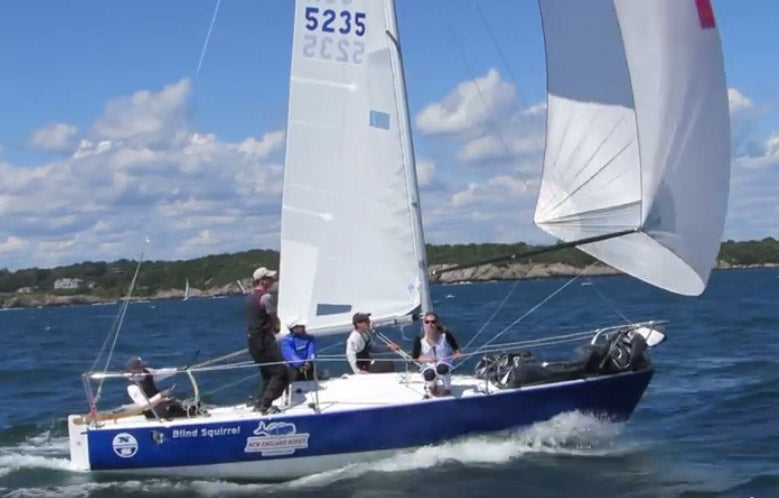
ROAD TO THE J/24 WORLDS
J/24 TIPS FROM THE EXPERTS
Upwind & Downwind Techniques to Get Your Team Up to Speed
Take some notes with Tim Healy, Will Welles, and John Mollicone on the fastest techniques for upwind and downwind sailing in the J/24. Crew weight placement, trimming techniques, and catching the perfect wave are the keys to success.
READ MORE
READ MORE
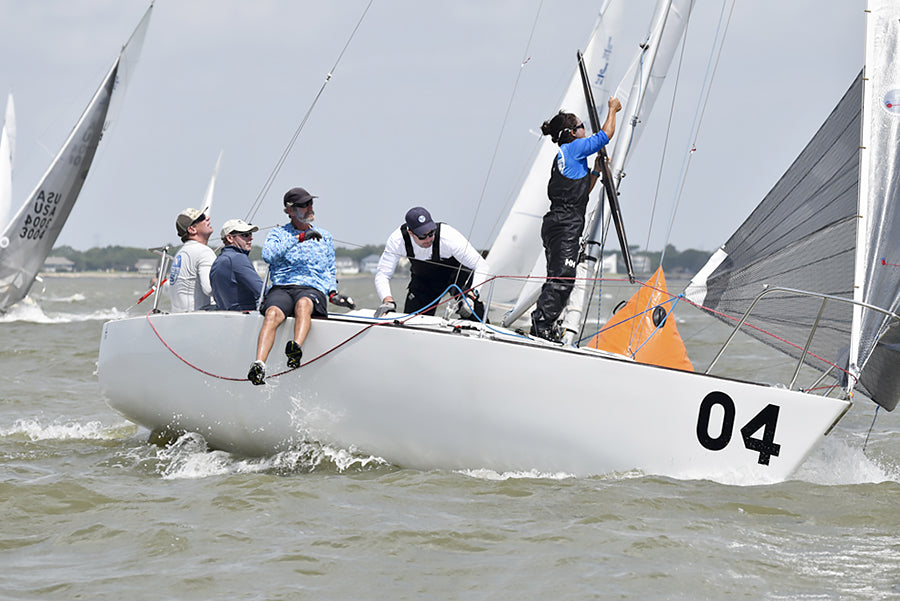
J/24 NORTH AMERICANS: WRAPPING UP A GREAT WEEKEND IN TEXAS
North Power Dominates J/24 North Americans with 1,2,5,6,8, and 10th Overall
Team ‘Bogus’. 2017 NA Champions! © Chris Howell
Another solid weekend under our belts as J/24 sailors headed to Houston, Texas for the North American Championship. Mother Nature dished up some great sailing conditions, ranging between 10-20 knots of solid breeze. Twenty-nine teams came to Houston to represent their hometown clubs, with only one winner in the end!
North Sails Saturday kicked-off with expert Mike Ingham giving a thorough morning weather briefing, providing insights on trending conditions that were expected that day, and assisted competitors with their rig set up. Expert Will Welles joined Mike after sailing, debriefing sailors on what they saw on the water and facilitating a group discussion about what worked well, and what didn’t.
Great competition and perfect conditions made for an all around successful event with North Sails three-time champion Will Welles, securing 1st place yet again with his all-star crew on ‘Bogus’: Jeff Linton, Erik Rexford, Chris and Monica Morgan, earning 4 bullets out of 10 races. Mike Ingham took 2nd with his team ‘Nautalytics’, Carter White with team ‘Sea Bags Sailing’ placed 5th, followed by St. Petersburg local Todd Fedeszyn with his team ‘Spoony Tactics’ in 6th. Natalie Harden close behind in 8th with team ‘Giggles’, and ‘Muy Muy’ with skipper Patricio Sly in 10th; all powered by North Sails.
Congratulations to our clients for their amazing performance this weekend. Keep up the hard work- Worlds is only 3 months away!
Full Results
© Chris Howell
© Chris Howell
© Chris Howell
© Chris Howell
© Chris Howell
© Chris Howell
© Chris Howell
© Chris Howell
© Chris Howell
© Chris Howell
© Chris Howell
© Chris Howell
© Chris Howell
© Chris Howell
© Chris Howell
© Chris Howell
READ MORE
READ MORE
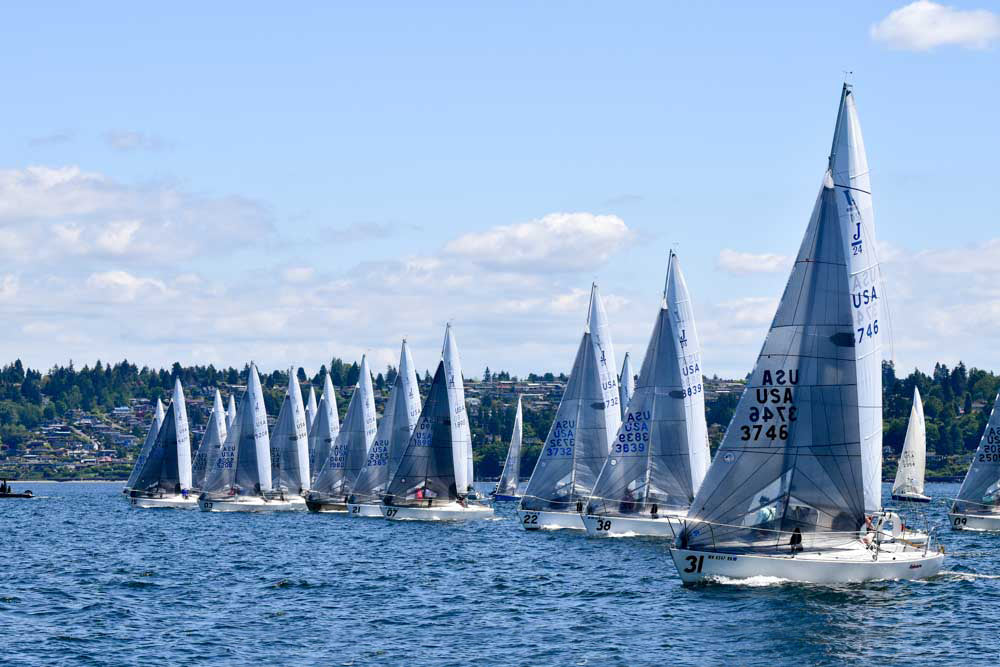
J/24 NATIONALS: SEATTLE, WA
North Sails clients take 9 of top 10 positions at 2017 J/24 US Nationals
J/24 Nationals is a wrap! Thirty two boats participated in the three-day championship, with strong participation and support from local J/24 Fleet 26. Aside from racing, the sailors enjoyed making new connections and learning what they could from each other. Lots of factors in the game for this event, with light air and strange current in Puget Sound keeping sailors on their toes. Nine races with a generous discard gave sailors a break, however the scores stayed very close in the top 10 positions.
Thursday was designated as a practice day, though without enough wind to sail, the North Sails on-site team hosted a dock talk. Lead by North Sails experts Will Welles and Brian Janney, who finished 2nd on USA 5208, the dock talk allowed for a beneficial group discussion among competitors. Many questions were asked and answered. Local sailors shared knowledge of the sailing area and sailors from around the country shared techniques.
The fleet was very competitive in light air, which was prominent throughout the event. Current and eddies along the shoreline were considerations, which made decisions tricky and the importance of making the right decision even more of a priority. Playing the current well served huge gains, as well as spending as much time as possible on the lifted tack upwind. Keeping your head out of the boat and eye on the dark water was also very important and made a big difference within the top 10.
© Chris Howell
“It was never the same way twice it seemed,” said Welles, who placed 2nd at the event. Local sailor Keith Whittemore and his crew on Tundra Rose leveraged their intel particularly well on the 2nd day, judging when the wind wouldn’t shift any farther right. They placed their bets on the left side early which proved beneficial. The current was also much stronger on the left, but that being said it was hard to decide if it was worth getting into. The wind was still so light there was concern that it could be impossible to get out of the strong current when it was time. Boat speed was important, but so was staying between your competition and the marks.
The breeze filled in much sooner in the day on Sunday, allowing the committee to get in three good races before the event came to a close. Keith and his team were able to minimize mistakes, allowing them to stay out ahead of the pack the majority of the time.
“They were unbelievably fast,” said Will.
A fun regatta with newfound friends and experiences to remember, are the things every sailor in the J/24 fleet can take away from this event. Welcoming new sailors to your home club and sharing your knowledge of the craft shows a lot for the J/24 class and its sailors as a whole. Big thanks to Seattle Fleet 26 and RC volunteers for making this event a success. Will commented,
“Sailing with friends is what it’s all about”.
Congratulations to our clients for their strong performance in the top 10, and special congrats to Keith Whittemore and his team Tundra Rose for taking the overall win.
© Chris Howell
© Chris Howell
© Chris Howell
© Chris Howell
© Chris Howell
© Chris Howell
© Chris Howell
© Chris Howell
© Chris Howell
© Chris Howell
© Chris Howell
© Chris Howell
© Chris Howell
© Chris Howell
© Chris Howell
© Chris Howell
© Chris Howell
READ MORE
READ MORE
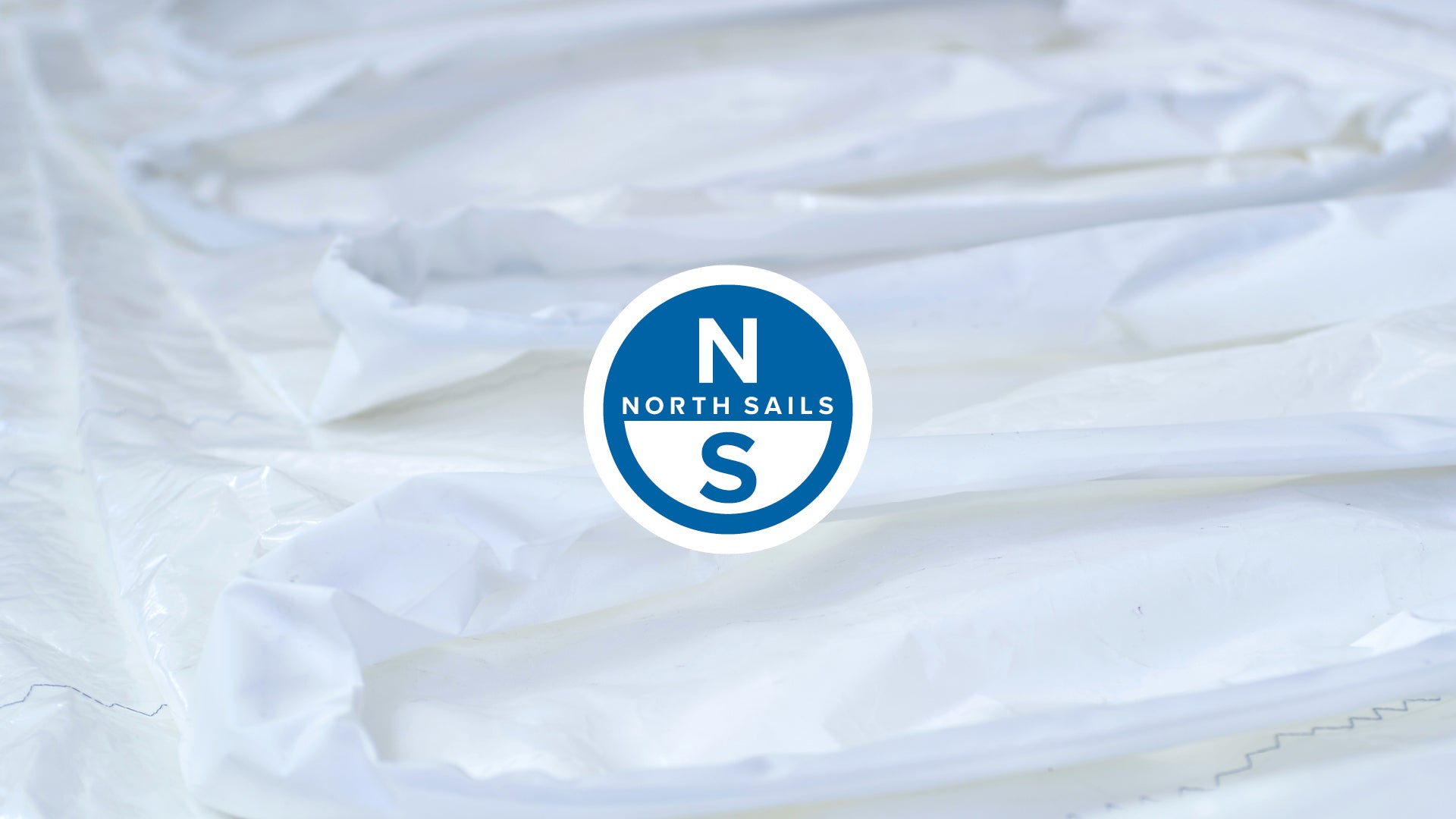
J/24 TUNING GUIDE
Download North Sails J/24 Quick Tuning Matrix: Loos Gauge PRO PT2 | Loos Gauge PRO Model B
Thanks very much for purchasing your J/24 sails from North Sails! We appreciate your business. This tuning guide will help you set up your boat for your new sails. If you have any questions along the way, please give us a call or send us an email. We are always ready to help you and your crew to get the most out of your new sails. Also, we have posted many J/24 related articles that will help improve your understanding of this great boat.
This tuning setup is designed to be as “all purpose” as possible. Like many one designs, the J/24 uses just a few sails to cover a wide range of wind and sea conditions. Set your boat up the way we have described here, and you will have great speed in all conditions.
WITH THE MAST DOWN
Measure the length of your spreaders from the side of the mast to the point where the shrouds touch the end of the spreaders. The spreaders should be as short as possible, 760 mm.
Make sure the spreaders are swept back the same amount on each side:
Tie a small string tightly between the shrouds just above the spreaders
Set the mast on sawhorses, track facing up, with the mast butt (plug in place) resting on a horse.
Using the back edge of the mast shoe as your guide, check to see the string between the shrouds and aft edge of the mast shoe are parallel. (See picture #1)
Picture 1 – If not parallel you will need to take the spreaders off and slide the thru bar in your mast to one side or the other to compensate. If you do not have a thru bar either file down the stubby male fittings or use spreader adjusters to make the sweep the same on each side.
Now check the deflection of the spreaders. This is the distance between the taut string and the aft side of the mast. For the Fathead main this should be 160-165 mm.
If your mast has not been shortened before, measure down the mast from the forestay fixing point as described in the class rule 3.5.2 (7725mm down from headstay pin center). You will need this mark later to find out if your mast can be shortened. You want your mast as short as possible.
The headstay should be as long as possible. To check this, attach the headstay and hold it alongside the front of the mast and make a mark on the headstay corresponding with the mark in Rule 3.5.2 (7725mm down from headstay pin center).
WITH THE MAST UP
Have a class measurer with an approved jig inspect your mast to make sure it is as short as possible. The mark you previously made on the mast must be no lower than 400mm above the sheerline. We like to cut our mast so the lower edge of the band is 405 mm above the sheerline to ensure that our mast will always measure in. See picture #2.
Picture 2
Step the mast and attach all shrouds very loosely (except the backstay) leaving any mast blocks out for the moment. Temporarily hold the mast butt in place on the “I” beam with a pair of vise grip pliers.
Make sure that the mast is positioned as far aft at deck level as possible. Have a friend hold the end of your tape at the stem measurement point and measure again straight to the lower edge to the mast band. We want this measurement to be as close to maximum as possible, 2925mm. Chock the mast at the deck to hold it in this position. See picture #2 above for determining measurement point at stem.
The next step is to place the butt of the mast in the proper position on the “I” beam down below.
Picture 3
Using a friend to hold the end of the tape, measure from the top of the third bolt holding the stem fitting on (inside the boat, up in the bow) to the intersection of the front of the mast and the shoe that rides on the “I” beam. This measurement should be 112.5”.
Hold the mast butt in place at this position temporarily with a pair of vise grips.
Now tighten the upper shrouds to 20 and the lowers to 15 on a Loos Model B tension gauge. Snug the uppers first and then, using the genoa halyard, measure down to the chainplates on both sides to be sure the mast is centered in the boat. Sight up the backside of the mast to be sure it is straight.
Now we will check to make sure the mast butt is in the right place. With the backstay connected (but very,very loose) measure the tension on the headstay. The tip of your gauge should be about 40-50 mm from the close side of the headstay wire. See picture #4 below. (Note: We typically use an older, separate Loos Gauge B for the headstay measurement to keep the new one in good condition!)
If your headstay is tighter than this, you will need to move your butt aft slightly; if it is looser, move it forward slightly. After moving the butt, check and adjust the tension on the shrouds before you recheck the headstay tension.
This should set up your mast with 2 – 2.25” of prebend. To verify, hold the taut main halyard at the gooseneck and sight up the back side of your mast. If you see something different, recheck your measurements.
TUNING CHART
The J/24 has just 4 sails to cover the entire wind range for racing. For the best performance in each condition, we adjust shroud tension depending on wind speed. As the final step in setting up your boat, fill in the attached tuning chart with how many turns of the turnbuckles it take to get from one setting to another. We often adjust our shroud tensions between races (it is against class rules to do so while racing), and it is impossible to get accurate tension gauge readings while the sails are up if there are any waves at all.
NEW LOOS GAUGE PRO MODEL PT-2
Wind Speed (Knots)
Uppers Tension
Uppers (Turns from Base)
Lower Tension
Lower (Turns from Base)
0-5
13
-1
9
-1
5-8 – BASE
15
BASE
12
BASE
8-10
17
1
13
0.5
10-12
18
0.5
15
0.5
12-14
22
1.5
18
0.5
14-16
24
1.5
22
1
16+
26
0
26
1.5
OLD LOOS GAUGE PRO MODEL B
Wind Speed (Knots)
Uppers Tension
Uppers (Turns from Base)
Lower Tension
Lower (Turns from Base)
0-5
18
-1
10
-1
5-8 – BASE
20
BASE
15
BASE
8-10
23
1
18
0.5
10-12
24
0.5
21
0.5
12-14
27
1.5
24
0.5
14-16
29
1.5
27
1
16+
29
0
31
1.5
Special note on the backstay: Adjusting the tension of your shrouds changes backstay tension too. Each time you tighten or loosen your shrouds, be sure to tighten or loosen the two smaller backstay turnbuckles too, so that the blocks riding on the backstay bridles stay 6-8” below the “y’ in the backstay when the adjustment line is slack. This is very important to make sure the headstay can get tight and loose enough depending on conditions. (We typically adjust 6 turns on each backstay leg between settings.)
You are now ready to start sailing!
SAIL TRIM
Follow these guidelines to set up and trim your sails.
Mainsail
Outhaul
0-4 knots: Clew should be ½ “ from black band
4+ knots: Clew should be at band
Cunningham
No cunningham until about 12 knots, then tension until wrinkles in luff are just removed.
Vang
Upwind, keep loose to 8 knots. 8-15 knots, tension to remove all slack. Above 15 knots, tension very hard so boom does not rise at all when the mainsheet is eased.Downwind, tension so top batten is parallel to boom.
Traveler
Keep all the way to windward until entire crew is sitting on weather side with legs out. As soon as crew is on the weather rail with legs over, drop down 6”. After that, use it to keep the boat flat by letting it down until the leeward edge of the car is in the middle of the track. If you have to drop below midline to keep the boat flat, pull on more backstay. We do not like to sail with the traveler to leeward of midline.
Backstay
Use to control fullness on main and genoa. Leave loose until about 8 knots. Slowly tighten as breeze builds to depower boat. At its tightest, the blocks will be all the way down to the top of the pushpit. A small adjustment (1-2”) can have a big effect. Be sure to adjust the backstay turnbuckles with the shrouds.
Mainsheet
Up to 10 knots of wind, tension the mainsheet so the top batten is parallel to the boom and the top tell tale is flying 50-60% of the time. In more than 10 knots, the top tell tale should be flying all the time, because the top of the main will be flatter.
Genoa
Trimming the genoa involves three major adjustments: lead position, halyard tension, and sheet tension.
Halyard Tension
Set the halyard so the luff of the genoa has just a hint of wrinkles. We have found that it is much better to have the halyard too loose than too tight. In light air, make sure that the luff is nice and loose. As the wind builds, tension the halyard to smooth out the luff
It is important to have a few marks on your genoa halyard near the cleats or stopper to duplicate fast settings for a range of conditions. We mark off ½” increments on the line.
Lead Position
It is important to drill two extra holes between each of the factory-drilled holes in your genoa track. The standard spacing is too far apart to be workable.
Having the lead in the correct position is critical for good speed. In moderate breeze (4-8 knots), trim the sail in and position the lead car so that the sail touches the spreader and the chainplates or turnbuckles at exactly the same time. Mark this position. This will be your neutral point for your jib lead.
Sheet Tension
We check the sheet tension by judging how many inches the sail is trimmed away from the end of the spreader. Generally we never trim the sail tighter than 1” from the end of the spreader.
MAINSAIL SETTING CHART
Wind Speed (Knots)
Traveler
Backstay
Topp Batten Angle
Outhaul
0-6
All way up
None
Closed 3 degrees
In 1/2″
7-12
Down 3-4″
1/4 on
Closed 3 degrees to parallel
In 1/2″
12-18
Middle
1/2 to 3/4 on
Parallel to open 3 degrees
In 1/2″
18+
Below CL 2-3″
Max on
Open 3-6 degrees
In 1/2″
GENOA SETTING CHART
Condition
Lead
Halyard
Sheet
0-6 Flat
1 aft of neutral
Wrinkles
3-4″ off spreader
0-6 Choppy
On Neutral
Wrinkles
3-6″ off spreader
7-13 Flat
On Neutral
Just smooth
2-3″ off spreader
7-13 Choppy
1-2 holes forward
Wrinkles
2-4″ off spreader
14-18 Choppy
1-2 holes forward
Smooth
4-6″ off spreader
18+ Choppy
On Neutral
Tight
6-8″ off spreader
Change your settings depending on the condition. As the wind builds and dies, you should be constantly adjusting the genoa sheet.
Class Jib
For fine-tuning the lead position, drill two extra holes between each set of factory holes in the jib track. Start with the jib lead block even with the chainplates and fine tune the lead position from there.
Unlike the genoa, the luff of the jib should always be smooth. In moderately heavy air, you can get the luff too tight. The luff of the sail should break evenly up and down. If the sail breaks high first, move the lead forward; if it breaks low first, move the lead back. Check this carefully and make a mark on the deck in the correct spot.
Sheet tension is critical. We like to adjust the tension on the jib sheet to balance out the helm. If the boat has a bit of weather helm, trim the jib slightly to pull the bow down. If the boat has leeward helm, ease the jib slightly. Because it’s a high aspect sail, you only need to change the tension on the sheet a small amount (1/2” increments) to have a significant effect.
Spinnaker
The spinnaker should be at full hoist at all times. The general rule of trim is to allow 2-4″ (50-102 mm) of curl in the luff of the sail. Set the outboard end of the pole at the same height as the free floating clew of the sail, and pull back on the guy until the pole is perpendicular to the apparent wind. Use the upper pole ring for most conditions. If you are going slow, try raising the pole a couple of inches.
Downwind — Light air
Concentrate on good communication between helmsman and spinnaker trimmer. The goal is to sail as low as possible, while still maintaining good pressure in the spinnaker (measured by tension on the sheet). Try not to sail too high and add distance, but do not sail too low at a slow pace. Be careful not to pull the pole too far aft because it flattens the spinnaker.
Downwind — Heavy air
Don’t square the pole back too far as this makes it easier for the spinnaker to roll out to weather. Do not let the clew of the spinnaker go past the headstay. To sail low without rolling to weather, keep most of the crew hiked to leeward.
Downwind Tips
Pole height is important and changes in increments of 1″ (25 mm) have a big effect on the spinnaker. The luff of the sail should curl evenly from top to bottom. If the spinnaker breaks high, raise the pole. If the break is too low, lower the pole.
Whether or not you use tweakers (or twings), it’s crucial to have a foreguy system that locks the pole in place. Every up and down or back and forth motion of the pole (and hence the spinnaker) is energy that will not be pulling the boat forward.
An efficient system for launching and retrieving the spinnaker is another must. We recommend a deep cockpit launching bag. Call us if you would like one made for your J/24.
In conclusion:
Always sail the boat as flat as possible, except in very light air
Sail as close to the max crew weight limit (400 kg) as possible.
Do not be afraid to change settings if you are slow.
Set up a tuning chart and use it.
Have open positive communication on board.
Sail fast and have fun!
SAIL CARE
Your North Sails are constructed out of the best materials on the market today. We make sure of this by testing every roll of cloth we use. Through proper care and maintenance, your sails will give you the performance you have come to expect.
The most important factor for long sail life is to watch for signs of wear and tear in high load and chafe areas. Be sure to wash the sails off with fresh water, and dry the sails thoroughly before storing. A dry, mild climate is best. Excessive heat can cause problems with the sails due to the possibility of shrinkage. It is best to roll the mainsail, genoa, and jib.
Mainsail
When hoisting and lowering the sail, try to minimize the amount of creasing or wrinkling of the sail. Every time the sail gains a crease, the cloth breaks down that much faster. Always have someone control the leech and luff during these procedures.
The battens can be left in the sail without any problems. Be sure to roll the sail down the leech so that the battens will not twist, which could damage them.
Genoa
With today’s Mylars becoming softer, rolling the genoa has become more difficult. When folding, creasing can develop along folds and accelerate the breaking down of the Mylar. The worst case scenario is for the sail to be rolled and then folded.
Jib
When rolling the jib, keep the battens perpendicular to the leech. Pay special attention to the battens and batten pockets for wear and tear. Since this sail is manufactured from yarn-tempered Dacron, problems can arise due to mishandling.
Spinnaker
Caring for the spinnaker is fairly straightforward. Be sure to repair all tears and pulled stitches as soon as possible. Store the sail folded.
This tuning guide only begins to cover all there is to know about racing the J/24, so North Sails J/24 experts have prepared a professional, in-depth J/24 racing clinic to help you and your fleet improve. In the course of an evening or weekend, you will learn more about racing your J/24 than you could possibly learn in a season of racing on your own. For more details, please call a North Sails J/24 expert!
At North Sails, we are constantly striving to make our products better. If you have any comments on this tuning guide, we’d love to hear from you. Please give us a call or send us an email.
READ MORE
READ MORE
J/24 FAQS
J/24 FAQs
A compilation of questions and answers we have received over the years.
What’s the recommended tension for the backstay?
With regards to the backstay, we think that having it off to measure would make it easier to get a method where all boats could be tuned the same.
With that in mind we suggest (this is in the tuning guide) that the tension on the backstay bridle always be adjusted so the blocks sit about 8″ below the triangle that joins everything together.. So each time you tighten or loosen the shrouds for a change in wind velocity you will need to do the same for the backstay bridle.
Can you give me some hints on how to go faster on a J/24?
It is really important to sail at max weight 882 lbs. In anything above 10 kts, that extra weight is noticeable in terms of upwind performance. At the top of the fleet, we try really hard to make sure we are max crew weight.
Changing gears in the J/24 is huge! The skipper has a lot on his plate. The top guys make the skipper responsible for the backstay, traveler, mainsheet, genoa trim and steering the boat. Let me try to explain how this works. A nice steady breeze makes it a lot easier obviously. In the steady breeze you can kind of get things set up and just rumble. In a puffy breeze, there is a constant adjustment of the controls.
You want to start by getting your boom at centerline. You accomplish this with mainsheet tension and traveler. The mainsheet tension controls the amount of twist in the sail and leech tension. In light air or light spots, you want twist (and the top leech tell tale flying) so softer mainsheet tension and a higher traveler to keep boom at centerline. A twisty main is also good for accelerating or for bow down modes. You want nice twist in your main after a tack to help the boat get back up to speed quickly. In medium breeze, you want a tighter mainsheet to close the leech a little for better pointing. You have to ease traveler down to keep boom at centerline if you pull on mainsheet tension. The only time you let the boom go below centerline and go traveler down is when you really need to de-power and keep the boat flat. Even before a lot of traveler down, I am usually putting on some backstay to de-power.
The backstay has a few rules of thumb. Take some off for more power and pull some on to de-power. If your main starts to invert and flog, you should ease some backstay to get flow over the sails going again. Backstay is more of a macro adjustment unless it is really puffy, then you are constantly easing it off in the light spots. Also, if you are ever overstood in breeze and need to crack off, put lots of backstay on. If you need to point higher in a short distance like if you understood the windward mark, take backstay off.
The genoa trimming by the skipper is key. Basically the skipper sits right next to the winch that has a winch handle in place. In a puff the trimmer, who is hiking out all the way, will ease the genoa in anticipation of the puff, not letting the boat heal over (we’re talking like a foot or more of ease at times), and then the skipper winds the winch handle to crank the sail back in before the boat heals to windward. This takes some practice, but once you get it, it’s huge. Never let the boat heal to leeward. Anytime the boat is healing it is sliding sideways a lot faster than you think. When a 30 knot puff hits, you actually have better VMG if your boat stops dead in the water and remains flat, than if you heal over, go forward but slide sideways. The boat that stopped dead in the water will actually be closer to the windward mark after the exchange.
How often do we get new sails? The Genoa obviously takes the biggest beating. After only a couple heavy air regattas you will be able to notice a performance difference between a new and used sail. It’s not only the beating the sail takes against the mast in tacks, but also the crew stuffing it up on the bow during downwind sailing. You might not like to hear this but we make sure we have a new Genoa for every big event.
What do I do when a puff huts?
Puff hits…crew eases genoa, skipper eases traveler.
Puff begins to ease up,skipper pulls traveler back up, cleats it. Then moves quickly to the winch handle and cranks in the genoa.
Repeat the above sequence with each new puff.
There are different variations of this depending on-strength of the puffs. If the puffs are very strong…vang sheeting-becomes a little more effective. A super tight vang and using the process above, but instead of easing traveler down, you’re easing mainsheet.
The backstay should be set as close to a happy-medium as possible, but every now and then it should be adjusted based on the overall trend of the breeze. I like to have it eased in the light spots as much as possible, as long as you can get enough back on before the next big puff hits.
It would be nice to have three hands. Trust me it is not easy…it takes a lot of practice.
I’ve been told J/24’s roll tack easy enough. Using techniques I adapted from dingy racing and a basic knowledge of hydrodynamics, I tested this theory and couldn’t get it to roll over. Is there a better technique for fixed keels that i don’t know about?
Roll facing out and push down on the windward life line. Start from the middle of the boat and do it all together. With four people rolling you should be able to get the windward rail all the way down to the water, once it is flatten the boat slowly and you will get a nice squirt forward.
What is your opinion about having multi color sails. I read somewhere that it was better to have one color due to the stretch in the panels over time. Is this a big issue?
We highly suggest having the head and clews of the sail each a solid color. Also I would try to have these areas lighter colored if possible. This way the top and bottom of the sail is made from the same lot of cloth and it will stretch relatively evenly over the life of the sail. Also making the sail with lighter cloth in the top and bottom will insure that you are getting a sail made with Grade A woven cloth. With darker colors flaws can be hidden and even though all the cloth is tested by the maker and us this generally seems a safer bet.
The tuning guides tell me about which ring to fly the pole from but as the wind builds I find that the floating tack sometimes wants to fly quite high. The question is, once you have got the pole to horizontal, do you keep raising the pole to keep the kite level or do you use the barber hauler (twinning lines) to keep the floating tack down to the pole tack. Does water conditions affect your thinking on this?
Generally the J/24 likes the pole on the low side so while we try to keep the clews level we also work on keeping the pole end a little lower than the free flying end. We generally twing the pole side down enough that the pole will sit right up at the tack of the spinnaker at all times.
Generally do not use the leeward twing on a J/24. The boom acts as plently of a twing when needed.
When to move the mast butt position?
There is no real reason to have to change the mast butt position once you find the proper location. Here we use a Loos Model B tension gauge and with the lowers on 21 and the uppers on 24 we measure the headstay tension with the backstay completely disconnected. The headstay will be loose and the tip of the gauge should be about 30 mm from the headstay if you have everything set up right. You will also have about 3 to 4 cm of prebend at this point. The only time I have seen adjusting the butt while racing work is when it is really blowing hard (25 knots plus) and then moving it forward just a bit MIGHT help.
How to ease and trim the main and jib together smoothly? Well..easing isn’t hard but since I grind the winch for the jib/genoa and pull in the main they don’t come in together, it’s always one or the other first. Both together is obviously better but I’m not sure how to do it. Do you have the cockpit guy grind in the jib himself and only worry about the main when both are eased or do I just try to do both myself. How do you do it?
You are talking about when you are cross sheeting the genoa and jib. Basically I think the best thing to do is if you just ease the jib a inch or two, you need to grind the sail back in a keep the cockpit guy hiking out.
Yes the sail will not be trimmed in exactly the same but I think this is less disruptive. If you have the ease the jib a lot (like when ducking) have the cockpit guy turn around and grind and tail the sheet him/herself. This way you can concentrate on the mainsail.
The balance between the two sails on a boat like a J with the a small keel is important. Keep playing the sails in concert with one another.
How can I get my J/24 to point higher?
Generally the reason a J/24 does not point (or sail as close to the wind as the boats around it is because the boat is not developing enough weather helm. The boat needs a small amount of weather helm to be able to always sail as close to the wind as possible.
The first thing to do is to recheck your boat against the tuning guide to make sure you have followed everything correctly. If this is so then I like to go out sailing with the rig tuned properly for the wind and take a close look at the mainsail set up. Usually what you will find in these cases is that the lower part of the main to too flat relative to the top of the sail. In general the sail should have a nice smooth shape from top to bottom, often in cases where the boat is not pointing well the bottom of the main will be very flat right off of the mast indicating that we need to move the mast butt forward. Start by moving it ¼” and see if that makes a difference, it should make the lower part of the mast a lot straighter and give you more helm and height!
My J/24 sails nice and high but I can’t get it to go as fast as the other boats through the water. What can I do?
You basically have the opposite problem of the folks in the question above. There are times in race where tactically you want to ” put the bow down” and just go fast regardless of height. If your boat won’t do this you are handicapped a bit. The problem is that your lower mast is too straight which makes the main too full and causes you too develop an excess amount of weather helm. Every time you try to sail the boat low and fast the boat heels too much and develops more weather helm. Move the mast butt back ¼” to put in more lower bend, recheck your shroud tensions and you should be all set.
Should I use the upper or lower ring on the mast for the spinnaker pole?
With the Slant Nose+ spinnaker we use the lower ring until about 15 knots of wind. For the FR-2 spinnaker use the lower ring until about 10 knots.
When I sail in heavy air with the jib I can’t get the jib halyard tight enough to remove all the wrinkles in the luff of the sail?
Above 20 knots you want the luff of the class jib smooth with no wrinkles. To get the halyard tight enough sail downwind before the start with the backstay off and have two crew pull up the halyard. This should get it tight enough. Be sure to get the jib up BEFORE you tighten the backstay at the leeward mark.
How important is the J/24 spreader angle adjustment? This seems to be hard to get right.
The spreader angle is hard to get right but it is worth the effort. The spreader angle affects how “stiff” the mast will be in the boat. Angle the spreaders forward and the mast gets stiffer, sweep back and the mast gets more flexible. This is important because as we tighten the backstay we need a certain amount of stiffness in the mast so the headstay will get tighter and flatten the genoa as the breeze builds.
If you have a older mast with “male” stainless steel fittings coming off the mast we suggest either retrofitting to a thrubar set up or using the Allis Racing style spreader adjusters. With a newer mast you may need to bend your thru bar to get the right angle (see your local machine shop).
Have a Question? Ask the J/24 Experts
READ MORE
READ MORE
HOW TO PREPARE FOR A BIG J/24 REGATTA
HOW TO PREPARE FOR A BIG J/24 REGATTA
A Basic Check List
A basic check list that the North Sails J/24 team and two-time World Champion Will Welles uses when preparing for a big J/24 regatta.
Let’s start at the top…first you need a boat!
BOAT PREPARATION
Hull
Proper keel shape
Keel max forward
Keel max depth
Faired: keel, rudder and bottom
Rudder hung at minimum depth
Plumb boat to make sure keel, mast, mast step, mast partner, chain plates, jib and genoa tracks are symmetrical.
Wet sand and buff hull, bottom and foils prior to event.
Equipment
Sails! (Try to show up at the event with fresh sails)
Proper deck layout with upgraded fittings (make sure your gear isn’t going to break at the event!)
Newer Anodized Mast (if you have an old mast, don’t let this keep you from competing!)
Thru bar and spreader sweep set at 160 to 165 mm (tight fit!!)
Check over your boom for wear and make sure the outhaul is updated.
A good working spinnaker pole with ends that work properly. (Tapered pole at class minimum weight is nice.)
Check shrouds, backstay and head stay terminals for corrosion.
Newer halyards
Newer running rigging
Proper tiller and tiller extension that won’t break in a breeze.
Check all clevis pins, ring dings, bolts, screws etc…
NOTES:
Try to show up at the event with some time on the halyards and running rigging..this way the splices have had a chance to settle in and the sheets to wear so they’re not soapy and slippery.
We recommend a shackle on the main halyard, Genoa/Jib halyard and topping lift. None needed on the spinnaker halyard…tie a bowline!
Think about bringing a spare tiller extension and spinnaker pole as part of your optional equipment.
Measure
Your boat will be fully measured at the Worlds, we strongly suggest if the boat hasn’t been measured before you should get your local measurer to check the boat over. The last thing you want to deal with at the event is needing to change something in the parking lot…no matter how big or small a job it is! **Leave plenty of time for this so act now!
Here are some things that they will measure:
Builders weight
Keel measurements
Rudder measurements
Spin pole length and weight
Boom tip weight
Black bands on mast and boom
Mast height
Forestay length
Lifeline deflection and tension
J dimension
Sails
Transport
Proper tow vehicle
Serviced trailer
Working running lights
Proper padding for your mast, boat etc..
Proper ratchet tie down straps
Spare tire
Tire iron
Proper jack (probably not your car jack if you can help it)
I like to take a can or two of “fix a flat”
North Sails travel covers!
Paperwork
Class membership/ Sticker
Depending on the type of the event, you will have to be a class member to sail class sanctioned events. Registration is yearly for $65 or you can sign up for 2 years for $125. Register online.. You will receive your class card and a yearly sticker that needs to be on the stern of your boat.
Measurement Cert (required for the Worlds)
You need a valid measurement certificate.
Measurement form
Change of ownership form
Note that the all up dry weight + optional equipment is 1330Kg now, that is less than it used to be so you may have to re-weight.
One trick we use is that we write the weights of everything on each piece of equipment with a sharpie. That helps a lot!
Note that the optional and required equipment list needs to be filled out. Make sure you have it on the boat in case you are inspected.
Tuning
SAILS
Make sure you have a practice set a and a “Game Day” set of sails.
Do a couple of test runs on the new sails though to make proper marks on the boat
A basic sail repair kit is mandatory, this should include: tell tales, 4” sticky back-fixes all sails, hand stitching items with palm and small can of McLube.
Mclubing the tell tales on the genoa as well as the leech area hitting the mast is helpful.
If the weather gets down below 40 degrees, bring the spinnaker home to prevent seams from becoming unglued.
If it is really windy out: put Dacron tape over the mainsail battens to prevent from flying out.
MAST
Straight mast in boat over keel
No bends, etc…
Polish before hoisting
Inspect all fitting, bolts, ring dings, etc…
Install Teflon Tape at the spreader tips, bottom 2 meters of the upper shrouds and the front of the mast where the clew hits during tacks.
Mark all shrouds so they always go back into the same side of the mast to ensure a good tuning matrix.
Defer back to Equipment Section for more overlapping ideas.
SHROUDS
Look for rust in the swedge fittings on all shrouds, replace when needed.
At the beginning of the event (during the practice days), it is good to wind the rig up hard overnight to stretch the shrouds out, helping to settle in.
Always have a fast way to tune the rig: two adjustable wrenches tied together, turnbuckle handles, and proper screw driver, etc… make sure the system is in place.
CHARTS
Rig Matrix is a must have, written down in a water proof book on board at all times.
This is accomplished up on land or at the dock at the beginning of the event, checking throughout the regatta.
Nautical charts of the area are very helpful.
Tide charts of the area are key as well.
Team
SKILLS
There are 5 pretty defined roles on the boat, Bow, mast/twing, middle/tactician, cockpit/trim and helm. One of the cool things about the J24 is it really is a team boat, you’re as good as your weakest link and it is hard to win unless you have a team that understands these roles.
PERSONALITY
Let’s face it you spend a lot of time with your team, and the worlds is a solid week of on the boat, in the car and sharing housing. It is important to get along with your team and most importantly enjoy their company and have fun!
Fill your team with solid sailors. It is important that they understand each role on the boat; this really helps the team run like a fine tuned machine.
It is always nice if you have some crew that understands boat work, rigging, and general sail repair is good too!
There is always a ton of items to get the boat to the regatta and back again, it’s nice to have team members that are willing to pitch in and take on certain tasks, this makes it a team effort and doesn’t put the sole burden on one person. Left for one person it can be a big task and takes a lot of the fun out of the regatta.Know your crews strengths. Try to divide jobs/tasks up to members based on this. Don’t assign the best chief on the team the boat work tasks or vice versa…..you’re liable to end up eating sawdust sandos or worse!
Try to tackle the big tough jobs (like polishing the bottom with Teflon) as a team, it goes faster too!
SIZE
The max crew weight is 882lbs. We suggest sailing right at weight. Typically a team will have a set driver, trimmer, tactician and bow. Then crews tend to round out the weight with the mast position. The simple answer is, build around your key members and sail at max weight!
Logistics
Logistics are number one in our book! Some folks fly by the seat of their pants on this but it’s always a little less stressful to have things planned out well in advance!
HOUSING
Stay in a place where everyone has a bed, the days are long at any regatta and this is a week of straight sailing!
Try to stay as close to the regatta site as possible, walking distance in nice if you can swing it!
FOOD
We suggest to bring a simple snack on the boat, energy bars, peanut butter and Jelly sandwiches, diet coke, and lots of water!
Eat a good breakfast and lunch too!
SHIPPING
If you are shipping your boat to the event, remember: You can’t ship a boat last minute. Find a good shipping broker that you trust and hold on!
There are plenty of good charter boats in the states so please let us know if you need any help locating one.
You may bring some of your favorite Genoa blocks, sheets, tiller, spare parts or whatever, make sure you check your airline’s weight restrictions and bear in mind there are many good places here in the states to get items if you need them!
Sails, you may choose to fly with your sails, check the airline box restrictions and get the appropriate box. This will save you lots of extra $$ and if you’d prefer, let one of the North Sails One Design J24 gurus know and we will bring you a set in the van delivered at the event!
TRAILERING
Make sure you service your trailer, check the lights, brakes, etc…
Make sure you have proper padding for your trailer keel, pads, mast, rudder, etc…
Make sure to have proper tie down straps.
You will want a proper spare tire, lug wrench, jack, jumper cables, can of “fix a flat”, you get the picture!
Practice – Well, practice is key!
TUNE
You want to find a good tuning partner that is as fast or faster and wants to get the same things out of the tuning…has the same goals etc….Is willing to put the same amount of time towards the tuning and to share the data found openly between the two boats. The goal should be to make both boats fast and not just one!
Think about hiring a coach to help, a good coach can help with drills but also with the rig and sail set up. A good coach is always money well spent!
BOAT HANDLING
Boat handling is what it’s all about! If you think about it the corners are the one time in every race that you can pass boats quickly! Of course wind shifts and things too but those don’t always happen in every race…most times you are rounding a mark at least one time in a race!
Set a windward mark and a leeward mark. Start with them spread apart so you have plenty of time to get the kite up and then jibe a few times and round the bottom mark. Go around and around until you’re so tired you can’t do another lap! Take a break from time to time and move the marks closer and closer so at some point they’re so close you barley have enough time to get the spin up and then back down before rounding the marks…this will expose any weakness in your boat handling quite quickly! Then stop and break the items down and start over. The goal is to grow as a team and by the end be the best boat handling team on the course!
The other item that works well is some match racing with your tuning partner. We do this all the time, you’ll need three marks for this.
Racing
Go to as many regattas as you can leading up to the Worlds! What this will give you is confidence getting off the starting line and show you how you line up with some other teams.
THE EVENT
Check in
Make sure to have all your documents ready to go. Insurance, crew waivers, entry fees, class membership card, US sailing card (or the like) etc….you get the idea!
Remember, all of the people at check in are volunteering their time so please be nice to them!
Measurement
Your boat will go through the complete measurement process at the Worlds. Boat weighing, keel and rudder measurements, mast measurements, sail measurements, Equipment list, etc… I’d suggest trying to confirm these items before you show up at the event. You will still need to get all the measurements done again at the regatta but you may expose any potential problems prior to showing up at the worlds which will be less stressful to deal with ahead of time!
I’d suggest going through your required and optional equipment list and confirm the weights of things. Write the weight on the items so to save time later weighing the items. They should have a scale at the event for you to use as well but I strongly suggest showing up ready to go!
Most events have measurement sign up for all these stations, sails, crew weight, boat weighing, mast and boom etc….make sure you are proactive and get yourself on the list!
The more prepared you are ahead of time the less time you will have to spend at the event on these items to get passed in measurement. This way you can spend more time on the water!
Take some tools and spare parts…some etc. lead etc…all the scales seem to weigh differently, try and have items to fix and potential problems without having to run to West marine 20 times!
Have your rule book on hand just to clarify any items that may come up.
Docking
Bring tons of fenders and long dock lines.
Find out if the boats will be on the dock or on a mooring. Sometimes having a dock box is nice to store extra gear, tools, fuel etc…Dehumidifier is nice too!
Cleaning the Bottom
Bring a mask and a wetsuit to clean the bottom of your boat each morning!
SAILING A WORLD CHAMPIONSHIP
Big Lines
Figure out which end of the line is favored and then try and stick around that area. Don’t get caught too far away from where you want to be on the line!
Continue to track the wind shifts so you don’t get caught on the wrong side of the line. If the wind is all over the place I suggest hanging in the middle so you can make a last minute decision.
Lots of Boats
Remember the same basic rules apply with 20 boats or 100 boats…you want to get off on the favored side of the line with a good hole to leeward to you don’t have to tack for a while….carving a good hole on the starting line is what it’s all about….
With more boats and longer lines it is even more important to start on the favored end of the line. Make sure you get out to the race course early and do your homework!
Lots of boats = lots of traffic. Make sure all crew are looking for boats to prevent any collisions.
Protests
Try and sail clean and stay out of the protest room! If you find yourself in a protest make sure you have your rule book and a witness or two. Remember the protest room is always a 50/50 thing….if you fouled do your penalty and if you’re the protestor make sure it is really a valid protest.
On the Water Etiquette
Try and represent your country well in a proper seaman like fashion.
READ MORE
READ MORE
